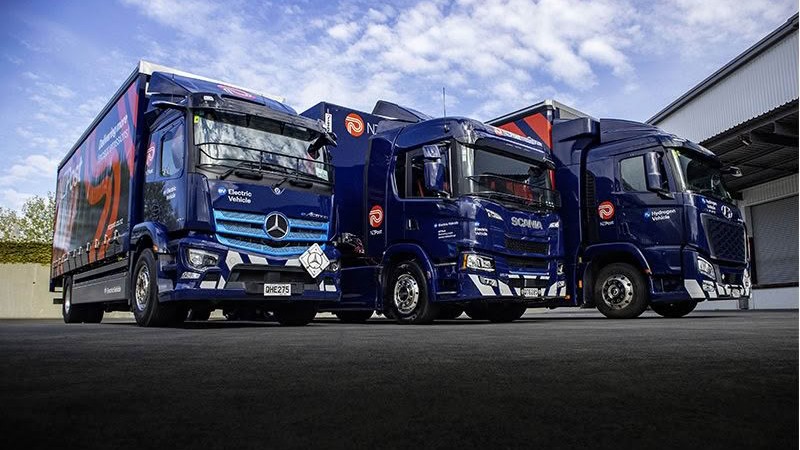
NZ Post is among the country’s leading companies when it comes to operating alternative-power vehicles. From motorcycles to vans, it has long focused on electrifying its vehicle fleet. It was among the first locally to start operating electric trucks and the first to operate a hydrogen fuel-cell electric vehicle.
With the NZ Post programme running for a few years, and with five heavy EVs and one heavy FCEV in operation, we were welcomed to document the journey so far. The result is a New Zealand Trucking cover feature unlike any before, comprising three different trucks from three different OEMs – not to compare them, but to see how each is being put to work moving the nation’s post and parcels with zero tailpipe emissions.
PART I
Save for a few who have thrown themselves headfirst into the future of alternative propulsion, it would probably be a fair bet many of us don’t realise how much activity is going on in the background among New Zealand’s transport operators. As they go about their daily business, many are acutely aware that times are changing, and that they need to – at the very least – start thinking about the future makeup of their fleet.
Featuring Reliance Transport’s Scania 25P electric trucks on the cover of the February 2023 issue was a milestone for New Zealand Trucking. We decided years ago we wouldn’t feature an alternatively fuelled truck on the cover of the magazine unless it were in operation on par with its ICE peers – doing the daily grind for an operator who had taken the plunge and put its money where its mouth is. That’s to say, not merely ‘on trial’. In the early stages of the EV story, expectations of return on investment would come second to the upfront cost of getting going – and the knowledge and experience gained in this ‘brave new world’. With its two Scania 25Ps and company-wide Project Switch programme, Reliance Transport had set itself up as a Kiwi frontrunner in the operation of heavy electric vehicles.
While those two trucks continue to operate with a no-news-is-good-news report card – just like any other in the fleet – much has happened in the heavy-truck space in the 21 months since they went on the road. Each year, industry conferences and events place a greater focus on alternative propulsion, with increased discussion on the topic and more of a showcase by OEMs, distributors and associated suppliers. New models are becoming available at a faster rate. Once, words like ‘electric’ and ‘hydrogen’ might have been either uttered in a hushed tone with a glance over the shoulder or accompanied by an eyeroll or two. Today, the industry is noticeably sitting up with interest. The amount of space our own publication dedicates to the topic increases consistently.
But rewind another year to February 2022, and we reported on Hyundai New Zealand’s launch of its Xcient FCEV, which took place towards the end of the previous year. Billed as New Zealand’s first hydrogen-powered truck, it was the first of five the company planned to introduce to New Zealand. As a hydrogen fuel-cell electric vehicle, it utilises compressed hydrogen gas to produce electricity by way of a chemical reaction in an onboard hydrogen fuel cell that powers its electric drivetrain.
By July 2022, an Xcient FCEV had entered service with NZ Post, the first of its kind to be put into commercial operation in New Zealand. In July this year, that truck clocked over 100,000km. The milestone coincided with NZ Post adding a Mercedes-Benz eActros 300 and three Scania 25P tractor units to the fleet. Now is perfect timing, then, to find out about the company’s alternative propulsion journey and see the trucks in operation.
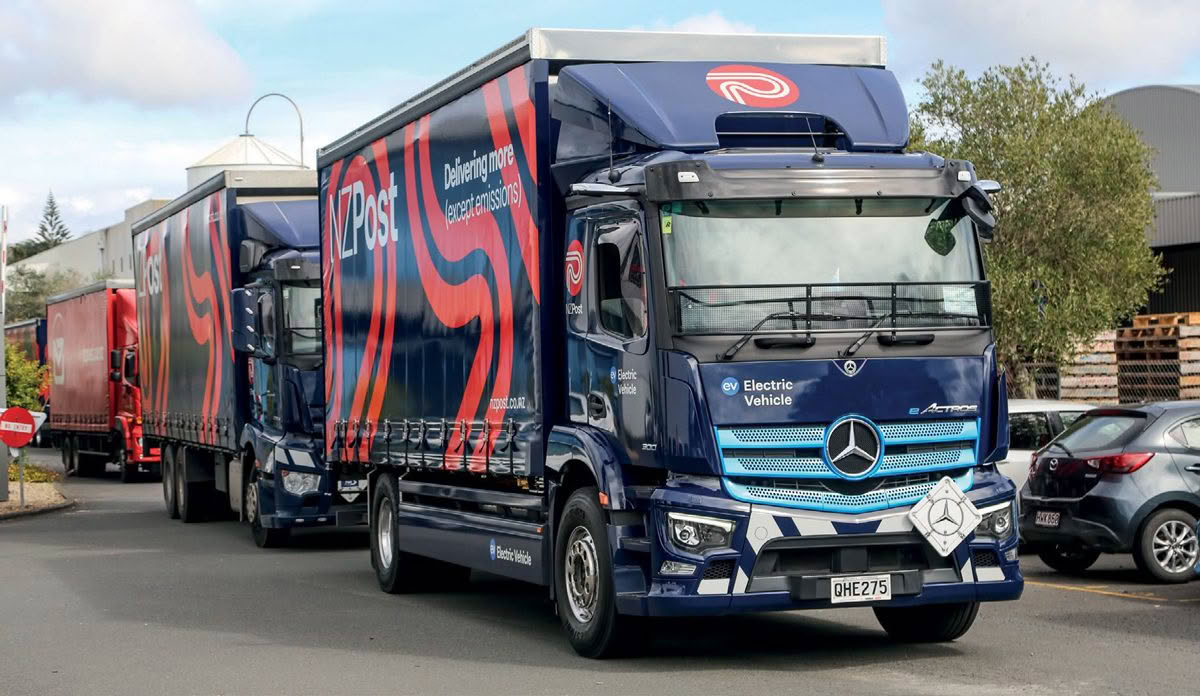
eActros heads out of the North Shore depot for another run to Silverdale.
Eyes on the target
At this point in history, companies setting and committing to achieving climate targets are nothing new. From the biggest corporates to the smallest sole operators, whether government-mandated, customer-initiated or done just because it’s the right thing to do, the drive to be environmentally conscious in as many areas of business as possible has experienced an increasing groundswell year on year.
For a corporate the size of NZ Post, all the above applies. The government has set its targets over the years, customers are becoming more attuned to how their parcels are delivered, and the company knows it’s the right thing to do.
“Our sustainability division set science-based targets for our emissions, and with the road fleet being the biggest emitter in the business, I had a bit of responsibility around that,” explains Ryan Beale, national road operations manager, as we sit down to discuss the journey so far.
Conor Keane, sustainability programme manager, elaborates: “In 2018, NZ Post committed to reducing its scope 1, 2 and 3 greenhouse gas (GHG) emissions by 32% by 2030 from the 2018 base, and committed to being carbon neutral by 2030. That was best practice at the time, but we updated our science-based commitment in 2023 to be a net-zero emissions operation by 2050 and reduce our GHGs by 42% by 2030 and 90% by 2050. It’s a more ambitious target, due to the changing science and increasing urgency.”
Conor says that the company is currently recognised as committed to net zero by science-based targets, but to become verified, it is exploring the individual transport mode pathways within the business, and what technology and investment will be required to meet that 42% reduction.
“A number of assumptions underpin these pathways, so from heavy freight, that means exploring the technology of trucks, charging, dual fuel and things we haven’t even considered yet.”
As Ryan alluded, transport is the biggest emitter in the business – accounting for 97% of emissions. International air freight is the highest emitter, followed by road freight and domestic air freight. “A sizeable portion is from heavy road freight,” says Conor. “To date, we’ve prioritised the decarbonisation of our vans, cars, forklifts and motorbikes, and then we have electric Paxters alongside the last-mile delivery contractor fleet.
“In tandem, we’ve been trialling a number of heavy freight options with the intention of reducing the emissions that come from our heavy freight by around 15% of the 42% reduction we require by 2030 – a sizeable amount.”
Currently, the company has set out to understand the TCO (Total Cost of Ownership) of the different technologies and – here’s a term most readers probably wouldn’t have encountered yet – the margin abatement cost (the cost to remove one tonne of CO2 over a vehicle’s lifetime). “We then start to get a picture of viability, combined with their operational suitability, and what the infrastructure we’d need to install is to facilitate different routes for these trucks. The more and varied environments we can put the trucks in, the more confidence we can have in them,” Conor explains.
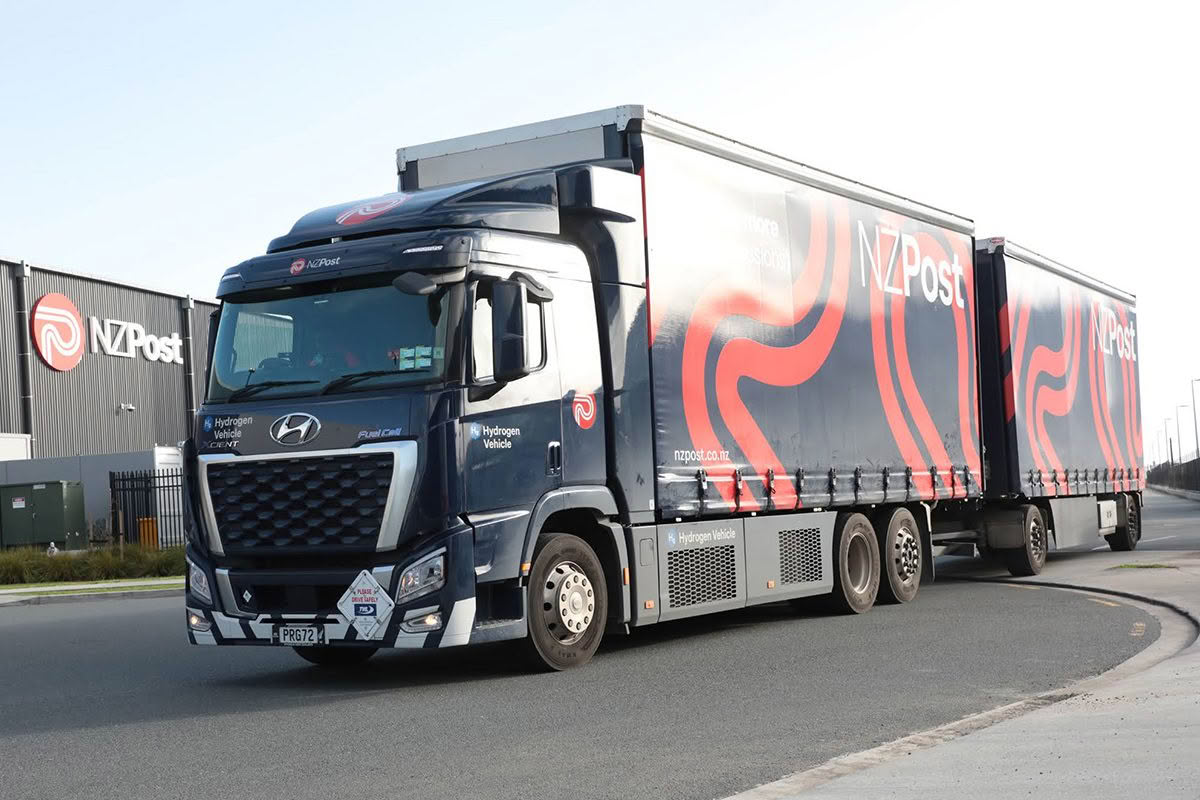
The Xcient FCEV leaves the APC, in the reality of mid- winter operation – looking like the real-world, double-shifted working truck it is.
Start early, start small
The race to meet ambitious targets can be daunting for any organisation, even one the size of NZ Post. However, size does have its advantages, creating options and flexibility with how to best ‘feel out the waters’, and repeatability and direct comparisons when it comes time to crunch the numbers. It also means that somewhere in the mix are loyal and dedicated operators who get the big picture and are willing to accept any challenges in putting the trucks to work early on.
“Around 28 years ago, NZ Post shifted to a contract model. Several existing employees shifted to that model, including Neil Dennett, Ramesh Lal and Greg Carley. They’ve all been with us for quite a while,” says Ryan.
Each is the custodian of a different vehicle in different use cases – Neil’s Shea Transport operates the Xcient, Ramesh’s Lal’s Transport the eActros (and earlier, a Fuso eCanter) and Greg’s Greg Carley Transport the Scanias. “The benefit we have is the fact we design our network to fit our requirements from a customer perspective. The luxury there is we have enough routes to pick from to put the vehicles somewhere they could work. The trucks are doing the Ks, and we’re enjoying it,” Ryan says.
But let’s not get ahead of ourselves … Once group sustainability manager Dawn Baggaley had set the targets, work had to be done to actually get the vehicles on the road. The team looked at the options available with insight from consultancy firm DETA.
“Early on, we looked at the eCanter when Keith Andrews’ demonstrator came in,” says Ryan. (We drove it for our May 2020 issue – Ed.) “It was cool, but our typical truck would start at about 18 tonne, and the eCanter was a lot smaller, so we were a bit apprehensive.” The roller cages NZ Post uses are designed to maximise the dimensions of truck bodies in New Zealand and accommodate as many as possible in each vehicle.
Eager to see how an electric truck would fare, by the end of 2022, an eCanter had nonetheless been fitted with as large a body as possible and was put into service with Lal’s Transport, running between the North Shore depot and Hibiscus Coast Operations Centre in Silverdale. Having completed 100,000km, that unit has now been shifted to a Wellington-based operator who was able to put a smaller vehicle to work and keen to see how an EV would do. This will yield valuable insight, too, as in his care, the truck will cover more distance each day but move less volume.
Ryan says the eCanter has been very dependable. “It did go to Keith Andrews for a bit of work at one stage, which they addressed. But for the run, the only limitation was the capacity of the unit. Once we knew what the parameters were and worked within it, there were no concerns.”
Naturally, putting a heavy EV to work requires supporting infrastructure, and there were early lessons regarding charging. Ryan explains that NZ Post does not want its vehicles to contest with public charging and has worked with Auckland-based commercial electrical services company Trilect to install YHI chargers. “We learnt quickly that the charging has to fit for it to work,” he says.
Needing to keep pace with volume growth in the North Shore region, and specifically the Hibiscus area this vehicle supports, the eCanter was replaced by the eActros in July. It was a natural progression and immediately doubled vehicle capacity and more than doubled on range.
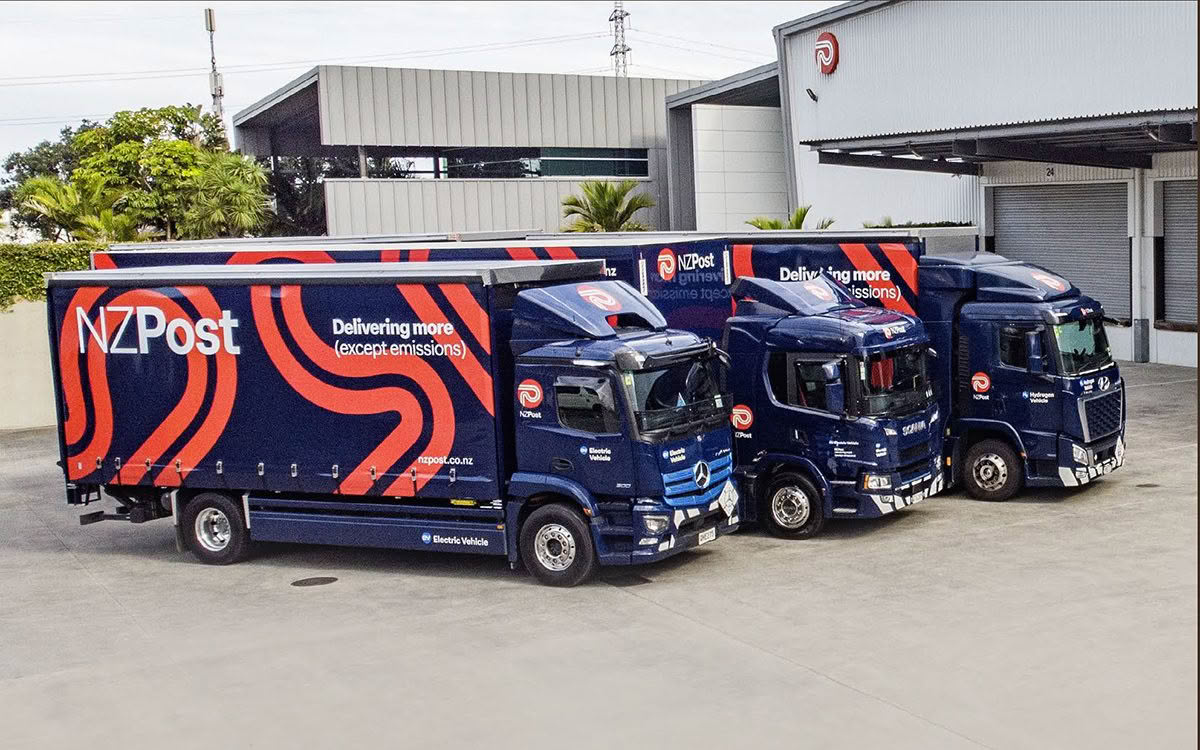
Chemistry between them
As we said earlier, the Xcient was, in fact, the first alternatively propelled heavy EV to go to work for NZ Post in mid-2022. “That was a long path,” says Ryan. “Two years earlier, we were approached by Hyundai and told about the vehicles that had been pitched to Europe; they wanted to bring some to New Zealand. With the targets set for us to understand how to fulfil our requirement, we needed to start dabbling. We got in behind it to make it work with Neil. He operates 15 contracted runs for our business, so we found a similarly matched vehicle on similar work that he was comfortable to replace with the Xcient.
“By 2021, we had concrete direction; we were going to go there. Neil understands technology is changing and we approached him because we thought his run was the best fit. We chatted about different options and how it would work. He and another contractor were involved in some of the design aspects. The path was troublesome for Hyundai, which had to bring the vehicle in and change it to right-hand drive, and Grant [Doull, national manager, hydrogen and eco commercial vehicles] spent a lot of time working around accommodating a European configuration within VDAM and applying for permits to get it on the road in 2022.”
“But,” says Ryan, “it was all of a sudden on the road and at work.” And, with little battery weight impacting the load, it could also tow a trailer and haul a load over the Bombays to Hamilton without much concern.
“Clocking 100,000km shows it’s just been there to turn up and work. There hasn’t been much issue with the gear, the tech works,” Ryan says. “Neil knew to the decimal what diesel he was using on the same route. The TCO is what we’re really interested in, and knowing what goes wrong over 1,000,000km with those trucks. With diesel, we’ve become accustomed to replacing certain parts eventually, but this truck is a bit different. During our lease time, we hope there will be a supporting network so that we can look at expansion. It’s as simple to operate as a diesel equivalent, and that’s what Neil was looking for. But, in six years, batteries could change significantly as well…” Ryan says.
Until recently, the only sticking point has been refuelling with hydrogen. However, determined to keep the truck working, Hyundai stood up an interim refuelling solution while Hiringa was getting its network online with Waitomo. “It was a chicken and egg situation,” says Ryan.
“It’s been interesting. One of the first things you’d hear was, ‘Do you want to drive around with a big gas tank on your back?’ But now the guys are used to it. Having Neil operate it, he can talk to other contractors, take them for a drive, show them the platform is workable.
“I can’t complain about it at all, and from a refuel perspective, 10 minutes is what the drivers are used to. Initially, hydrogen is a bit different, but once they know how it works the concern goes away.”
The first tractor units
Earlier this year, NZ Post moved into its new Auckland Processing Centre (APC) in Wiri. The new 30,000m2 hub can process more than 30,000 parcels per hour at peak capacity. Significantly, it brings together NZ Post, Customs and MPI for national and international processing on one site. This meant Customs’ air cans (the vessel in which airmail is stored for transport) would need to be transported to and from the site and the airport – and that meant more scope for new vehicles.
The timing being as great as it was, our initial visit coincided with the handover of three new electric Scania 25P 4×2 tractor units and their specialised 10m hard-side Fruehauf trailers with automated roller decks for loading and unloading of customs cans. Unlike the Xcient and eActros, both on six-year lease arrangements with TR Group, the Scanias have been taken on by NZ Post directly.
“We had a couple of 4x2s with 10m trailers in the fleet already and knew the configuration would be viable,” Ryan says. “Greg previously operated diesel trucks in a different configuration for our domestic air cans. When we said the new operation to transport international cans from the airport would be a great fit for electric trucks, he was comfortable with relinquishing some gear to take these on board.”
The Scanias’ operation will be of low mileage but high utilisation. Their docks at the APC have been equipped with two dual-gun chargers, so that they can top up every time they offload.
Conor says: “We’re confident the Scanias will be quite replicative of a lot of the trucks in our fleet. We’re comfy with the range; it’s more the operation, charging, loading and unloading where we need the assurance. Strategically, it could make sense to build out the network from one hub to leverage the infrastructure between the different Post hubs and lower the ratio of capital investment costs for charging. That’s the next step. Once we’ve decided on technology, we can decide how to leverage existing routes and sites to build that network as best as possible.
“We envisage these trucks would run longer than a typical ICE equivalent due to lower maintenance. Residual cost is still a variable due to the likes of battery degradation, but residual costs for a diesel will be, too, as we begin to transition. So, there’s uncertainty all round. It’s an industry challenge, but these trials will give us an understanding.”
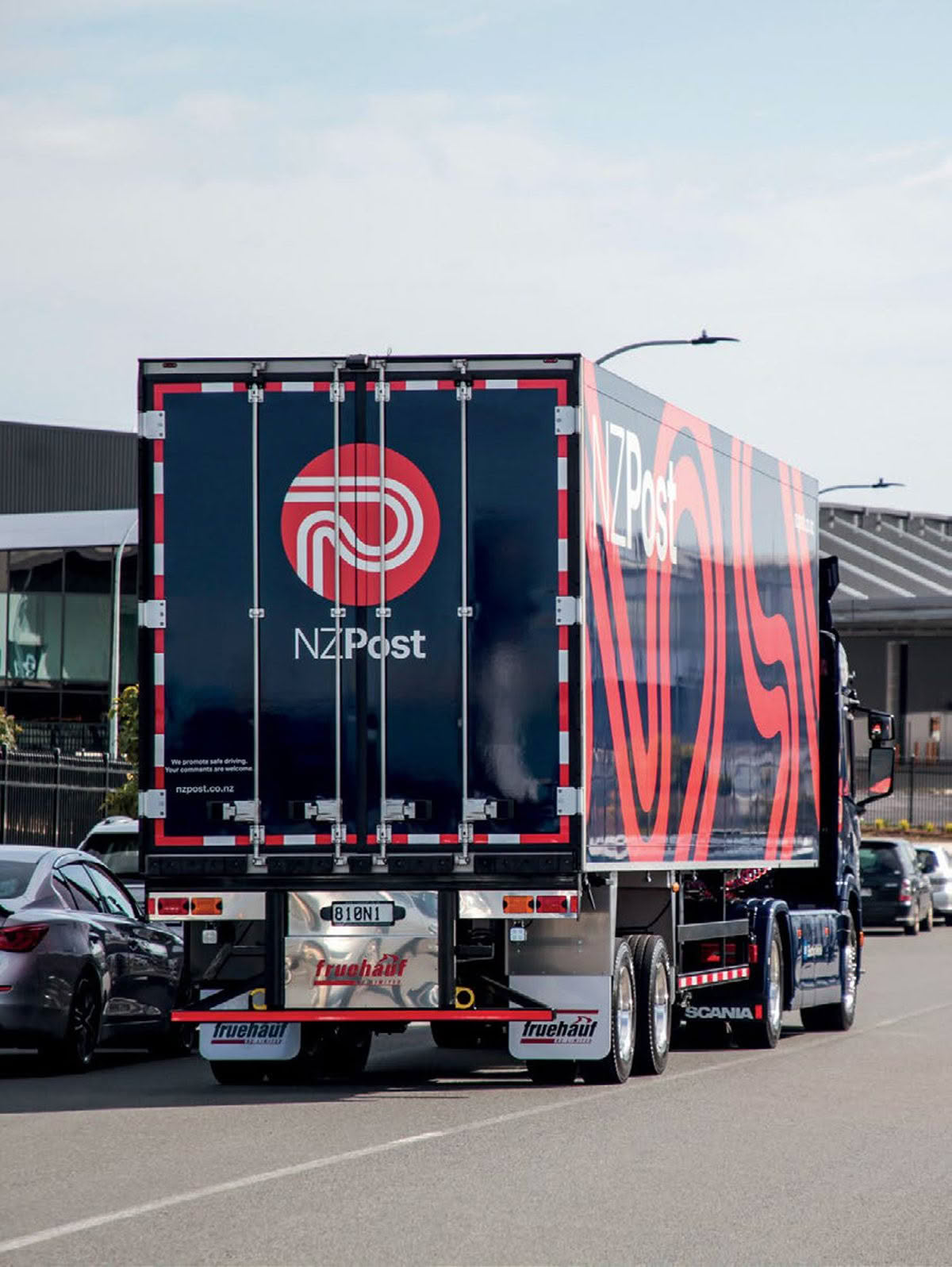
The Scania’s 4×2 and two-axle, 10m semi-trailer configuration is perfect for the transfer of airmail.
Only just beginning
Ryan echoes Conor’s sentiments: “The Scanias will be a great validation, allowing many contractors to see how it works and allowing us to understand where we’ll require the charging infrastructure. The trucks are all tangible; people can come drive them and see the benefits.
“In Auckland, we run a hub-and-spoke model. The Wiri APC and Highbrook AOC (Auckland Operations Centre) are our two main hubs sending freight out to the extremities of the greater Auckland region. So, this will allow us to determine where we can say, ‘The next vehicles with these contractors may need to be something similar.’ I feel, especially within Auckland, BEV will be holistically beneficial – for example, a truck sitting on Puhinui Road for half an hour idling is burning diesel for nothing.
“For the further-out sites, where we don’t need full truck-and-trailer spec yet, we’ll be range-testing and understanding that viability, getting that TCO and making the operators aware of what they’d be in for, and what we’d require around charging. Longer distance linehaul … we’re waiting to see what comes from the OEMs. Our Auckland-Wellington run leaves here at 8.30pm to be at the depot at 5am to present to the couriers before 9am. We can’t lose half an hour charging. But increased charging rates could be a game-changer… Look how we’ve gone from 50kW to 200-plus in the last few years. Refuelling or charging stations in the National Park would be ideal,” Ryan says.
None of that’s to say contractors are limited to the existing options. Dual-fuel conversions, such as those the likes of HW Richardson is pursuing, could also be a mid-term option for some contractors.
“Every time we’re presented with a new truck, we are starting to question what the best fit is. Because we own the network, we can specify the requirement and ensure we’re making the right decisions. The contractors so far have been involved and dedicated to making it work. I reckon 90% of our contracting fleet would be onboard with change if it were ready. Of course, we can’t charge our customers an extra 50% because we’ve gone zero emissions,” he says.
“We’ll continue to progress, and my belief is the market will continue to change. At the moment, these are quite early-generation trucks. The truck has to fit – and if we select a run, will it still fit in three to five years? We have to be open-minded, too. If we have to change the way we move the freight, then we may need to do that.”
Naturally, few operators have the benefits at hand that NZ Post is lucky to have, such as its size or ability to select from a pool of fixed routes. But what that does afford the rest of the industry is insight into how the vehicles can be expected to operate, what infrastructure is required and how it fits into the picture, and what needs to be done now to meet future expectations.
On that note, Ryan concludes: “If we want to advance this, the industry has to work together. New Zealand is remote, and it’s not easy to compete with scale. VDAM is also an issue. As a country, we all need to jump into it.”
What else is going on at NZ Post?
- Approximately 140 contracted heavy vehicles move the country’s post – these range from three-axle 18-tonne units up to full longhaul B-trains. Euro-5 is the current mandated emissions standard for new vehicles, with a move to Euro-6 set for March 2025.
- A concerted effort to move to electric and plug-in hybrid light vehicles has been made, with 585 such vans and cars in the fleet. Mercedes-Benz eVitos were allocated to depots requiring a van, and the company has recently kicked off a new cascade deal to reduce the cost for operators to get into an eVito.
- The company aims for 100% of its owned vehicle fleet to be electric by the end of 2025, with motorbikes and forklifts the last two vehicle types to be fully converted.
- A project to put a US-made Beta Alia e-cargo plane in operation between Wellington and Blenheim has just kicked off with Air New Zealand. “Air New Zealand feels the Cook Strait would be the ideal place to test it. Using it for cargo increases the strength and resilience that may be needed. We’re in the early phase of understanding the operational constraints before going operational in 2026. It will be the first battery electric domestic flight,” says Conor Keane, sustainability programme manager.
- Regarding domestic air cargo, the company has procured three new planes that offer greater fuel efficiency and reduced carbon emissions.
Quick reads from Test
Read more
The right man for the job
0 Comments29 Minutes
Legendary ambition
0 Comments36 Minutes
Hard Fought!
0 Comments40 Minutes















